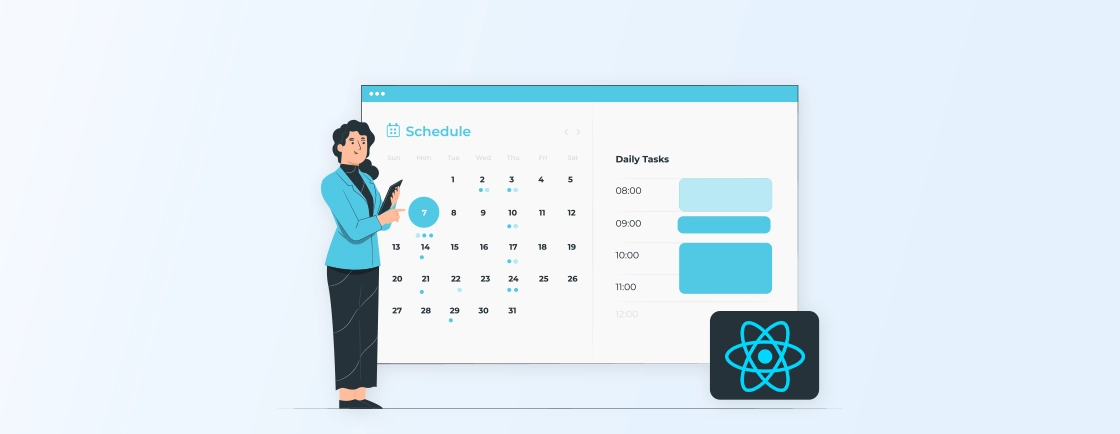Table of Contents
Have you felt the need for ready-made and reusable CSS that can make your React development quick? If yes, Bootstrap is the right framework you can use to build your React project. But how do you use Bootstrap with React? Well, there are several methods you can choose from based on your needs.
The easiest is using Bootstrap CDN, and if you are a developer, using React-Bootstrap is an optimized way. In this blog, we’ll dive into each of the methods to set up and use Bootstrap with React. With that, let’s begin!
What is Bootstrap?
Bootstrap is a popular open-source CSS framework used for building responsive and mobile-first websites. It provides pre-designed components like grids, navigation bars, buttons, and more, which help frontend developers create user interfaces quickly and consistently.
Key Features of Bootstrap
- Responsive Grid System: Bootstrap’s 12-column grid system is one of its standout features, enabling developers to create responsive layouts that adjust to different screen sizes.
- Pre-designed Components: It includes a wide range of pre-designed components, such as buttons, forms, navigation menus, and more. These components are fully customizable and can be easily integrated into your React application.
- Cross-browser Compatibility: Works consistently across different browsers, reducing the need for custom fixes and minimizing compatibility issues.
- Customization and Theming: Developers can customize Bootstrap by modifying its Sass variables or using Bootstrap’s predefined themes. That enables them to change the look and feel of a website.
- JavaScript Plugins: It comes with a set of JavaScript plugins that add interactive elements to your website, such as carousels, tooltips, and popovers.
What is React?
React is a JavaScript library developed by Facebook for building user interfaces, particularly for single-page applications. It enables developers to create reusable UI components, making code easier to manage and scale. React is focused on the “view” in the Model-View-Controller (MVC) architecture, allowing developers to build interactive web applications.
Key Features of React
- Component-Based Architecture: React breaks down the UI into independent, reusable components, each responsible for rendering a part of the interface. This allows for better organization and maintenance of code.
- JSX (JavaScript XML): It uses JSX, a syntax extension that allows developers to write HTML-like code directly within JavaScript. That makes it easier to visualize the UI structure within the logic.
- Virtual DOM: React uses a virtual DOM (Document Object Model), which optimizes the updating process. When changes occur, React updates only the necessary parts of the actual DOM, improving performance.
- Unidirectional Data Flow: React ensures a unidirectional flow of data, making it easier to debug and manage the state of the application. Components pass data to their children through props (properties).
- Declarative Syntax: React’s declarative style makes it easy to design UIs, where developers describe the UI, and React takes care of rendering the right components.
Benefits of Using Bootstrap with React
Using Bootstrap with React offers several benefits that enhance both the styling and functionality of React websites. Here are the key advantages:
Rapid UI Development
Bootstrap’s pre-designed components, such as buttons, forms, modals, and navigation bars, allow developers to build responsive user interfaces quickly. When combined with React’s reusable components, this speeds up the overall web development process. This integration is especially beneficial for creating consistent, visually appealing layouts.
Seamless Responsiveness
Bootstrap is built around a responsive grid system, ensuring that web applications automatically adjust to different screen sizes. When used with React, developers can easily create responsive, mobile-first interfaces without writing custom CSS.
Simplified Customization
Both Bootstrap and React are highly customizable. React allows developers to create custom components, while Bootstrap’s CSS can be modified to fit specific design requirements. This combination gives developers flexibility in customizing the look and feel of a website. Plus, both of these tools are robust in nature, ensuring high performance.
Cross-Browser Compatibility
Bootstrap ensures that components are consistent across all major browsers. By integrating Bootstrap with React, developers can rely on cross-browser compatibility while focusing on building dynamic, client-side interactions.
Easy Integration
Bootstrap is flexible when it comes to integration with React. Developers can incorporate Bootstrap via a Content Delivery Network (CDN), install it via npm, or utilize libraries like React-Bootstrap. These integration methods make it easy to use Bootstrap with React, providing developers the flexibility to choose the setup that best fits their project.
Enhanced Performance
It is primarily a CSS framework, and it doesn’t require jQuery for its core components, making it lightweight. React handles the dynamic updates, while Bootstrap provides a fast, streamlined design system. This combination ensures that both the frontend design and the application logic are optimized, resulting in a faster, more efficient web application.
Highly Scalable
As React applications grow, scalability becomes critical, and Bootstrap helps with this by providing a consistent grid system and UI components. React’s component-based architecture allows for the reuse of elements when used with Bootstrap’s classes. That makes it easier to build and scale complex websites easily.
These benefits of using Bootstrap with React make this combination a popular way to build dynamic websites. Now, let’s dive into how expert ReactJS developers set up their projects with a few easy steps.
How to Setup Bootstrap with React?
Adding Bootstrap to a React application can be done in several ways, depending on your preferences and project requirements. The three common methods are using Bootstrap CDN, installing Bootstrap via npm, and using the React-Bootstrap package. Below are the detailed steps for each of the methods:
Method 1: Using the Bootstrap CDN
This method involves linking Bootstrap via a CDN (Content Delivery Network) directly into your React project. It’s the quickest way to add Bootstrap styling without installing it as a dependency.
Step 1: Open the public/index.html file in your React project.
Step 2: Add the following <link> tag inside the <head> section to include Bootstrap CSS:
<link
rel="stylesheet"
href="https://cdn.jsdelivr.net/npm/bootstrap@5.1.0/dist/css/bootstrap.min.css"
integrity="sha384-KyZXEAg3QhqLMpG8r+Knujsl5/5hb7ie1L6qqpqQmPVwIDFbclq8MkuoaS3g+vdi"
crossorigin="anonymous"
/>
Step 3: If you need Bootstrap’s JavaScript components (like modals, dropdowns, or tooltips), include these scripts at the bottom of the public/index.html file:
<script src="https://cdn.jsdelivr.net/npm/bootstrap@5.1.0/dist/js/bootstrap.bundle.min.js"></script>
Step 4: You can now use Bootstrap classes in your React components. For example:
function App() {
return (
<div className="container">
<h1 className="text-center">Welcome to Bootstrap in React</h1>
<button className="btn btn-primary">Click Me</button>
</div>
);
}
export default App;
Ideal for developers who need a quick and easy setup, especially for small projects where customization is not essential. This method is suitable when minimal configuration is required, but it requires consistent internet access to load Bootstrap resources from the CDN.
Method 2: Importing Bootstrap in React as a Dependency
In this method, you install Bootstrap as a dependency in your project using npm or yarn, which allows for offline use and customization.
Step 1: Install Bootstrap as a dependency using npm or yarn:
npm install bootstrap
#OR
yarn add bootstrap
Step 2: Open your src/index.js or src/App.js file and import Bootstrap’s CSS:
import 'bootstrap/dist/css/bootstrap.min.css';
Step 3: If you need Bootstrap’s JavaScript components, make sure to import them as well:
import 'bootstrap/dist/js/bootstrap.bundle.min.js';
Step 4: You can now use Bootstrap’s classes in your React components, just as we did with the CDN method:
function App() {
return (
<div className="container">
<h1 className="text-center">React with Bootstrap via npm</h1>
<button className="btn btn-success">Click Me</button>
</div>
);
}
export default App;
Ideal for projects that require offline functionality and full control over Bootstrap versions. This method is great for teams that want flexibility, prefer managing all dependencies with npm, and want to create unique designs.
Method 3: Installing React-Bootstrap or Reactstrap Package
React Bootstrap packages like React-Bootstrap or reactstrap rebuild Bootstrap components as React components. This is a more React-friendly way of using Bootstrap and avoids direct manipulation of DOM elements or classes.
A) Using React-Bootstrap
For a more integrated approach, you can use the react-bootstrap library, which provides React components for Bootstrap.
Step 1: Install react-bootstrap and bootstrap using the command:
npm install react-bootstrap bootstrap
Step 2: In src/index.js, import Bootstrap’s CSS and the React-Bootstrap components you need:
import 'bootstrap/dist/css/bootstrap.min.css';
import { Button, Container } from 'react-bootstrap';
Step 3: Use the React-Bootstrap components in your JSX:
function App() {
return (
<Container>
<h1 className="text-center">Hello from React-Bootstrap!</h1>
<Button variant="primary">Click Me</Button>
</Container>
);
}
export default App;
B) Using Reactstrap
Similar to React-Bootstrap, Reactstrap offers Bootstrap components as React components, providing flexibility and ease of use. Here is how you can use it:
Step 1: Install reactstrap and bootstrap using the command:
npm install reactstrap bootstrap
Step 2: In src/index.js, import Bootstrap’s CSS and the reactstrap components:
import 'bootstrap/dist/css/bootstrap.min.css';
import { Button, Container } from 'reactstrap';
Step 3: Now use the components in your React code, here is an example:
function App() {
return (
<Container>
<h1>Welcome to Reactstrap!</h1>
<Button color="primary">Click Me</Button>
</Container>
);
}
export default App;
This method is ideal for professional ReactJS developers who want an optimized approach, using Bootstrap components. This method is perfect if you want to avoid external libraries and maintain a fully React-based environment for better scalability and maintainability.
Each of the above methods has its pros and cons, so choose the one based on your project requirements. If you just need basic styling, the CDN method is sufficient. However, if you want more component flexibility and control within React, React-Bootstrap or Reactstrap would be the better option.
Using Bootstrap Components in React
Once you have integrated Bootstrap with your React application, you can start using Bootstrap components to build your UI. Below are examples of how to use various Bootstrap components in a React application, using both plain Bootstrap classes and the react-bootstrap library.
Method 1: Using Bootstrap Components
Once you’ve added Bootstrap to your project using any of the methods mentioned earlier (CDN, npm, or a React-specific package), you can start using the Bootstrap components. Here is a example where we will use React-Bootstrap package:
import React from 'react';
import { Button, Alert } from 'react-bootstrap';
function MyComponent() {
return (
<div>
<Alert variant="success">
This is a success alert—check it out!
</Alert>
<Button variant="primary">Click Me!</Button>
</div>
);
}
export default MyComponent;
In this example, we import the Button and Alert components from React-Bootstrap and use them directly within our React component.
Method 2: Using Bootstrap Classes Directly in JSX
If you’re using Bootstrap through a CDN or as a dependency, you can apply Bootstrap’s utility classes directly to your JSX elements. Here is how:
function App() {
return (
<div className="container">
<h1 className="text-center">Hello, Bootstrap in React</h1>
<button className="btn btn-primary">Click Me</button>
</div>
);
}
export default App;
Here, the Bootstrap classes like container, text-center, and btn btn-primary are used directly in JSX, just like in any HTML file. This approach works well for developers familiar with Bootstrap and who want to quickly style their React components.
Customizing Bootstrap with Sass
Customizing Bootstrap with Sass allows you to tailor Bootstrap’s default styles to better fit your application’s design needs. Sass is a powerful preprocessor that enables you to modify Bootstrap variables and easily apply styles throughout your project. Here’s how to get started:
Step 1: To customize Bootstrap using Sass, you’ll first need to set up your environment with Node.js and npm. Ensure you have Bootstrap installed in your project via npm. Here’s how to do it:
npm install bootstrap
Step 2: You will also need to install Sass. You can do this via npm:
npm install sass
Step 3: Now, create a new Sass file (e.g., custom.scss) where you will override Bootstrap variables and include Bootstrap’s styles.
Step 4: In your custom.scss file, start by importing Bootstrap’s source files and variables:
// Import Bootstrap variables first
@import "node_modules/bootstrap/scss/functions";
@import "node_modules/bootstrap/scss/variables";
// Override Bootstrap variables
$primary: #ff5733; // Example of changing the primary color
// Import the rest of Bootstrap
@import "node_modules/bootstrap/scss/bootstrap";
By overriding variables like $primary, you can change the default styles of components that use this variable.
Step 5: Creating Custom Styles and Components
You can also create your own styles and components in the same custom.scss file. This is useful for adding unique styles that are not part of Bootstrap’s framework. Here is a example how you can add custom styles:
// custom.scss
.button-custom {
@extend .btn; // Extend Bootstrap button styles
background-color: $primary; // Use custom primary color
border: none; // Remove border
color: white; // Text color
padding: $spacer; // Use customized spacer
border-radius: 0.5rem; // Custom border radius
}
Step 6: Now, compile your custom.scss file into CSS. You can set this up in your package.json scripts section:
"scripts": {
"build-css": "sass custom.scss custom.css"
}
Once compiled, run the below npm command to build your project:
npm run build-css
Step 7: Include the compiled CSS file in your React application. You can do this in your index.js or App.js:
import './path/to/custom.css';
Step 8: With your customized styles in place, you can freely use Bootstrap’s utility classes and components in your React components. For example:
function MyComponent() {
return (
<div className="container">
<h1 className="text-primary">Welcome to My App</h1>
<button className="btn btn-primary">Click Me!</button>
</div>
);
}
Step 9: After making your customizations, test your application to ensure the styles are applied as expected. You may need to adjust your custom styles based on how they interact with Bootstrap’s components.
By customizing Bootstrap with Sass, you can create a more unique and tailored look for your website. This could be complex if you are new to frontend development. Therefore, it’s recommended that you get help from ReactJS development service providers.
Wrapping Up
Integrating Bootstrap with React is a powerful combination that can enhance your web development experience. By leveraging Bootstrap’s responsive design and pre-built components, you can quickly create an appealing and user-friendly React site. Here are the methods you can choose based on your project requirements:
- Choose Using the Bootstrap CDN if: You prefer a quick and straightforward way to include Bootstrap in your project without the need for installation.
- Choose Using Bootstrap in React if: You want to maintain full control over your Bootstrap integration without relying on external libraries.
- Choose Using React-Bootstrap if: You are looking for a more React-friendly approach that offers Bootstrap components as reusable React components.
If you are finding it hard to make extensive customization and need assistance with your project, hire ReactJS developers.
FAQs About Using Bootstrap with React
Can I use Bootstrap with any React application?
Yes, you can integrate Bootstrap with any React application, whether it’s created using Create React App, Next.js, or other frameworks. Just ensure you follow the appropriate installation method for your project setup, such as using the Bootstrap CDN or importing Bootstrap as a dependency.
How do I customize Bootstrap styles in React?
You can customize Bootstrap styles in React by overriding its default variables using Sass. First, install Bootstrap and Sass in your project, then create a custom Sass file where you import Bootstrap’s styles and customize the variables as needed. This allows you to maintain a consistent design tailored to your application’s needs.
Is Bootstrap faster than React?
Bootstrap is known for its extensive customization options, but its performance can be slower compared to React. React, with its component-based architecture and reusable code, offers a smoother user experience. Its efficient updates to the DOM often eliminate the need for full-page reloads, resulting in faster performance.
Propel Your ReactJS Vision
Explore modern React patterns, hooks, performance tips and let’s bring your next frontend project to life.





